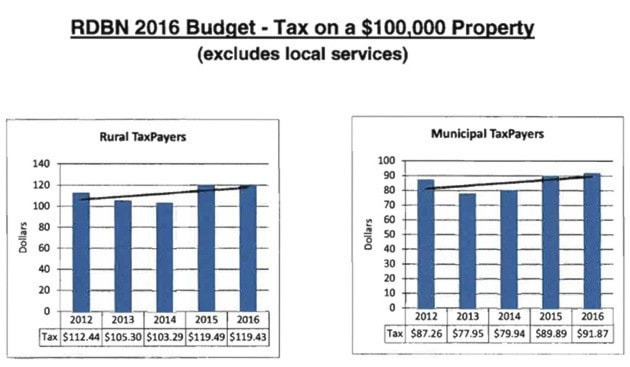Flavio NienowLake District News
Directors of the Regional District of Bulkley-Nechako (RDBN) will have an easier time presenting the RDBN’s budget to their constituents this year.
In March of 2015, the board was dealing with double-digit tax increases - region-wide services increased by 15.5 per cent while taxation on regional rural services increased by 22.4 per cent.
This year, taxation on region-wide services will increase by 1.1 per cent while taxation on regional rural services will decrease by 4.7 per cent.
Tax on a $100,000 residential property went from 0.9 per cent in 2015 to 0.92 per cent in 2016 for municipal taxpayers; for rural taxpayers, the tax rate remained at 1.19 per cent, same as 2015.
According to Hans Berndorff, Financial Administrator of the RDBN, the biggest factor behind the lower tax increases this year was an increase of $480,000 in last year’s surplus, which allowed the regional district to offset tax increases.
Other factors that contributed to the low increase this year include an initiative to bring the management of the landfills in-house, as opposed to contracting it out. As a result, landfill operating costs were reduced by $400,000. However, in order to reduce landfill operating costs, the RDBN was required to purchase new equipment, which will result in debt repayment over the next five years. Berndorff said the RDBN will likely see another significant tax increase at the end of that five-year period.
In addition, the RDBN has reduced its scrap metals budget from $150,000 to $25,000, and switched its 9-1-1 service provider - the RCMP - to E-comm, resulting in a decrease of $152,000 in this year’s budget.
After the significant increase in taxation in 2015, the board of directors highlighted the need to pay more attention to the financial implications of their decisions throughout the year. They proposed the creation of a finance committee that would provide guidance to the board of directors during the budgeting process. However, the committee was never created.
Last year the board also discussed if the RDBN had been relying too much on surpluses from previous years to offset tax increases. At the time, Smithers Mayor Taylor Bachrach said that although Smithers had used surpluses from previous years to offset tax increases, the town had never relied on surpluses to lower taxation.
Bachrach asked Bendorff if there was any way the RDBN could transition into linking its tax increases to changes in service levels, as opposed to relying on money from previous surpluses to lower taxation.
Bendorff answered by saying that this transition could result in even more taxation. “Once you’re in the mode of using prior years’ surpluses, like all regional districts do, it’s very difficult to transition out of that,” Berndorff said in 2015.
According to Bill Miller, Director of Electoral Area B, fluctuation in taxation is common. That’s why the RDBN has been looking at five-year periods to analyse tax increases.
Looking at the RDBN’s five-year trend, from 2012 to 2016 there was an average tax rate increase of 1.1 per cent for municipal taxpayers and 1.7 per cent for rural taxpayers.
